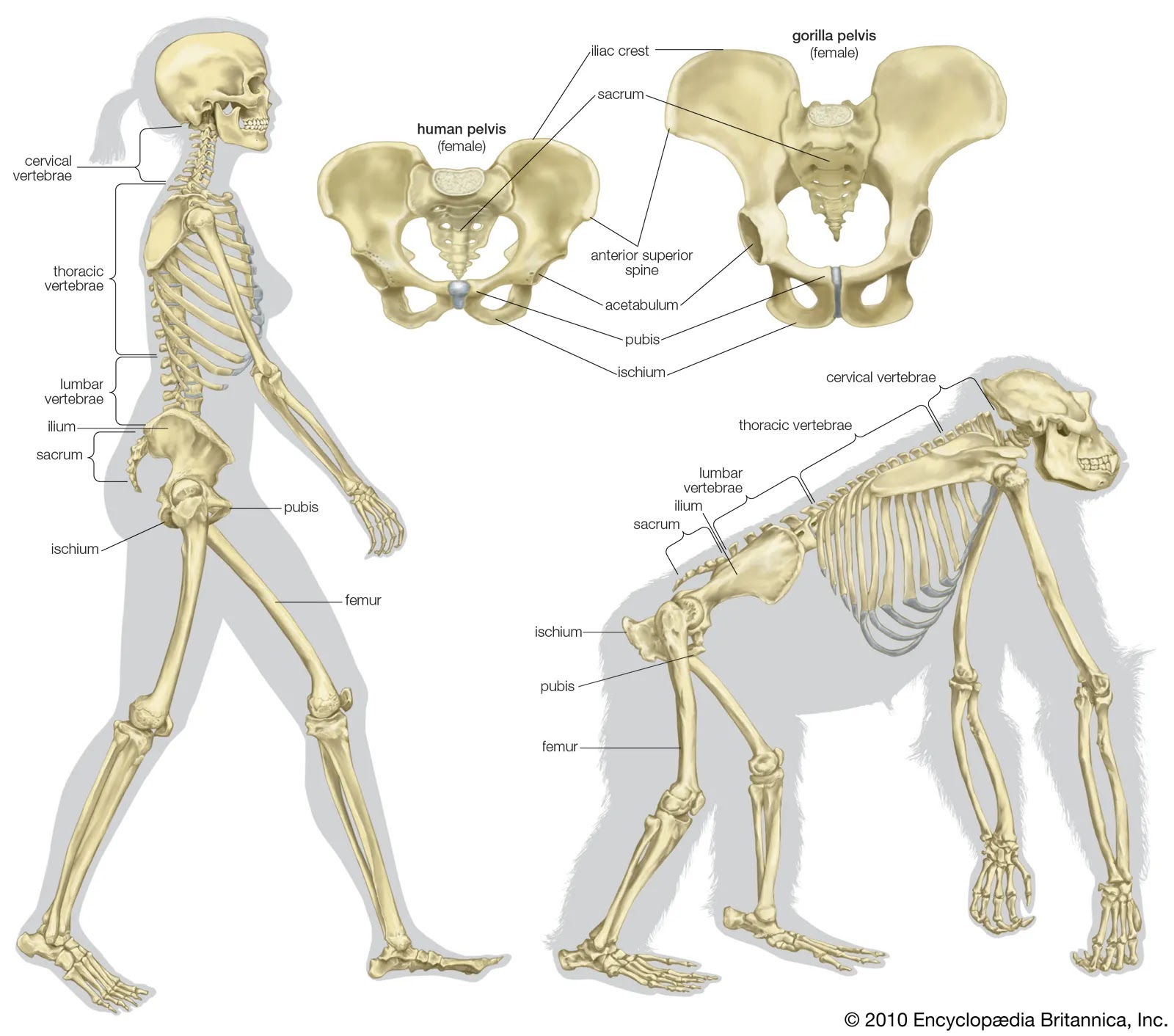What is a Hominin?

Encyclopedia Britannica July 19, 2022
Comparison of Human and Gorilla Skeleton
The term "hominin" has been revised over the past few decades and is now commonly used to describe all members of the human clade since its split from the shared ancestor with chimpanzees. Genetic and fossil evidence suggests that the first hominins (humans) split from this shared ancestor somewhere between 6 to 7 million years ago or mya. A number of possible transitional forms have been found which date between 4.5 to 7 mya with definite hominins having evolved by approximately 4.5 mya. These forms are considered 'definite' hominins because they exhibited two defining biological traits that distinguished them from the shared non-human ape ancestor - bipedalism and some significant changes in tooth morphology. As hominin evolution slowly continued over the next 4 million years, a larger brain size and more complex technology also developed.
Bipedalism
Biological evidence for bipedalism in hominins compared to that of non-human apes includes:
Size and Location of the Big Toe and Presence of a Foot Arch
With the exception of Ardipithecus ramidus, an early hominin, the big toe of hominins is enlarged and located at the front of the foot next to the other toes. The foot bones are curved to form both a transverse and a longitudinal arch. This creates a pocket of air beneath the foot when initially placed flat upon the ground, thus forming a cushion to resist compressive forces to the knees, hips, and spine.
Archaeological evidence of early hominin bipedalism has been found at the site of Laetoli, Tanzania. This site contains a series of footprints made 3.6 mya. These footprints clearly show the big toe next to the other toes as well as an obvious arch, and hence bipedalism. Approximately 70 footprints made by two adults and a child were uncovered. The track of the footprints is about 85 feet long and also includes 1000s of footprints of many other types of animals ranging from rabbits to elephants, as well as birds.
Read more Smithsonian's Laetoli Footprints
Shape of the Pelvis
In non-human apes the pelvis is elongated and oriented more or less parallel to the spine. In early and modern hominins, the pelvis is shorter, broader, and extends around to the side.
Angle of the Femur (i.e. Thigh Bone) and Changes in the Knee Joint
The femur of hominins angles inward from the top down toward the tibia in order to keep the foot beneath the center of gravity. The knee also angles inward and the knee joint can now lock which allows the leg to straighten.
Leg Length
Hominins have relatively long legs compared to the length of their arms.
Curvature of the Spine
Hominins have an anterior-posterior S-shaped curve in their vertebral column unlike the C-shaped curve of non-human apes. This offsets impact forces when walking upright in order to reduce pressure on the spinal column.
Location of the Foramen Magnum(i.e., the hole through which the spinal cord exits the cranial cavity)
The foramen magnum opens under the skull in early and modern hominins as opposed to the back of the skull in chimpanzees. The position of the foramen magnum beneath the skull indicates bipedalism because this means that the skull is balanced on top of the spinal column.
Evidence from Ardipithecus ramidus suggests that some of the adaptations for bipedalism may have begun in a wet forest region, and were selected when the environment became more arid with grasslands and woodlands increasing in size and pushing back the rainforests. A number of theories on the advantages of bipedalism in this newer environment have been proposed.
Advantages of Bipedalism in Early Hominins
- They could see over grasses in order to spot predators and see other group members.
- They could stay cooler and better regulate body temperature (although, this may not have been an initial advantage as the initial adaptation for bipedalism took place in cooler woodlands, not hot grasslands).
- They were able to carry things like simple weapons, such as sticks or rocks, as well as tools, food, etc.
- It was easier to graze and eat.
- They were more energy efficient since walking, although not running, on two legs uses less energy.
There were probably other advantages and no one advantage can explain why bipedalism was selected. The advantages must have been great, however, because bipedalism has many disadvantages.
Disadvantages of Bipedalism in Early Hominins
- They were much slower than the local predators and their gait was still awkward.
- They were small (3.5 to 5 feet in height), lacked claws, and did not have large canine teeth for protection.
- There is evidence suggesting some early hominins have been consumed by predators and, therefore, were actually prey rather than top predators.
By 1.8 mya humans, specifically Homo erectus, were exceptionally adept at bipedal walking and were much taller than their early hominin ancestors with some individuals reaching modern human height.
Tooth Changes
Initial changes in the dentition of early hominins include smaller, nonprojecting, canines as well as the absence, or reduction, of the diastema. In the mandible or lower jaw bone, the diastema is the space between the canine tooth and the third premolar and is where the upper canine tooth fits when the jaw is closed. In non-human apes, the relationship between the canine tooth and the third premolar is called the CP3 honing complex because when the jaw is closed the sharp edges on both of these teeth rub against each other which helps keep these teeth sharp. In addition to changes in the CP3 honing complex, the form of the premolar changed from a blade-like form with one large cusp and a much smaller cusp, to a broader premolar that had two cusps that were similar in size. Hominin molars also became larger and have thicker enamel than those of non-human primate apes.
The initial advantages of these changes in tooth morphology were possibly related to the changes in available foods. Rainforests provide fruits that are chewed in an up-and-down motion. Grasslands and woodlands provide seeds and nuts which are ground in a side-to-side motion. Smaller canines would allow the jaw to move back and forth in a grinding motion because the canine teeth would no longer interlock. Larger molars provide greater surface area for grinding and thicker enamel protects the teeth from repeated grinding motions. Relatively large jaws provide more grinding power. By 2.5 to 2 mya the jaw and molars began to decrease in size, possibly due to the use of tools to process foods.

